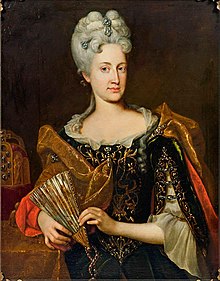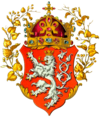Elisabeth Christine of Brunswick-Wolfenbüttel
| Elisabeth Christine of Brunswick-Wolfenbüttel | |
|---|---|
Holy Roman Empress | |
| Tenure | 12 October 1711 – 20 October 1740 |
| Born | 28 August 1691 Brunswick, Brunswick-Lüneburg |
| Died | 21 December 1750 (aged 59) Vienna, Austria |
| Burial | |
| Spouse | |
| Issue |
|
Catholicism prev. Lutheranism | |
Elisabeth Christine of Brunswick-Wolfenbüttel (28 August 1691 – 21 December 1750) was
Biography
Elisabeth Christine was born on 28 August 1691 in
At age 13 Elisabeth Christine became engaged to the future
Spain

At the time of the wedding,
In 1711, Charles left for Vienna to succeed his suddenly deceased brother Joseph I as emperor. He left Elisabeth Christine behind in Spain, appointing her as General Governor of Catalonia in his absence.[6] She ruled Catalonia alone until 1713, when the war ended with Philip recognized by all of Austria's allies. Her official role as regent had been to sustain the morale of Charles's Catalan subjects, but Martino claimed that she actually governed more effectively than Charles had during his Spanish reign.[6] She then joined her husband in Austria.
Austria

As empress, Elisabeth Christine as well as her predecessor were described as accomplished in music, discretion, modesty and diligence, and was regarded to fulfill her representational role as empress well both within the Spanish court protocol of hunting and balls and amateur theater as well as the religious devotion days of pietas austriaca.[7] She was an excellent shot and attended shooting matches, participated in hunting while she and her ladies-in-waiting dressed in amazon attire and also played billiards.[8] Elisabeth Christine was later rumored to be a crypto-Protestant, likely because she was a patron of Jansenists such as Johann Christoph von Bartenstein.[4]
Charles VI did not allow her any political influence whatsoever after her arrival in Austria in 1713. However, she was described as intelligent and self-sufficient, and she established political connections among the ministers, especially Guido Starhemberg; and she took some initiative to engage in politics on her own. In the 1720s, she appeared to have had some influence in the treaty with the Russian tsar through her family connections in Northern Germany, and she allied herself with the court faction which opposed the plans to marry her daughters to members of the Spanish royal house.[9]
The marriage of Elisabeth Christine was dominated by the pressure upon her to give birth to a male heir. This she later fulfilled when she gave birth to a male heir named Archduke Leopold John in 1716. However, at age 7 months the infant Leopold died. She reportedly found the situation very stressing and was tormented by the loss of confidence in Charles VI that this caused. [5] Three years after her marriage, court doctors prescribed large doses of liquor to make her more fertile, which gave her face a permanent blush.[5] During her 1725 pregnancy, Charles unsuccessfully had her bedchamber decorated with erotic images of male beauty so as to make her expected baby male by stimulating her fantasy.[5] After this, the court doctors prescribed a rich diet to increase her fertility, which made her so fat that she became unable to walk, experienced breathing problems, insomnia and dropsy and had to be lowered into her chairs by a specially constructed machine.[10]

Though her health was devastated by the different prescriptions as how to make her conceive another son, Charles VI apparently did care for her: he continued to refer to her by her pet name White Liz, expressed sincere concern in his diary about her health and left her an independent income in his will.[10] Charles had a mistress before the marriage, and he had a mistress, countess Althann, from 1711 onward, though Althann was not an official mistress and had been married to one of his ministers shortly before the arrival of the empress to make the relationship more discreet.[11]
Elisabeth Christine got along very well with her mother-in-law, Eleonore, and her sister-in-law Wilhelmine Amalia, and the three empresses were described as supportive toward each other: Wilhelmine Amalia nursed Elisabeth Christine when she had smallpox, and Elisabeth Christine nursed Eleonore during her last illness.
Despite her lack of political influence, she was successful in arranging the marriage of her niece
Empress Dowager
In 1740, Charles VI died, leaving her a widow. As a widow, she never received the large income left to her in the will of Charles because of the crisis of the state, but her daughter Maria Theresa provided a comfortable existence for her court.[10] As a widow's seat, she gave her Schloss Hetzendorf near Vienna.

Though the traditional view has been that she had a good relationship with her daughter the empress, there is actually nothing to confirm such a thing. While Maria Theresa is known to have freely expressed her affection for people she cared for, she never did so with her mother; she visited her regularly, but the visits were formal, and during her interaction she behaved strictly according to Spanish court etiquette.[13] In 1747, the Prussian ambassador claimed that she was politically active, "without arousing the suspicion that she is trying to meddle"[6] in political matters. Elisabeth Christine died in Vienna.
Children
- Leopold Johann (13 April 1716 – 4 November 1716), died in childhood.
- Maria Theresa (13 May 1717 – 29 November 1780), Holy Roman Empress, ruler of the Habsburg domains
- Maria Anna (26 September 1718 – 16 December 1744), governor of the Austrian Netherlandsfor a few months before her death in childbirth
- Maria Amalia (5 April 1724 – 19 April 1730), died in childhood.
Ancestry
| Ancestors of Elisabeth Christine of Brunswick-Wolfenbüttel | ||||||||||||||||||||||||||||||
|---|---|---|---|---|---|---|---|---|---|---|---|---|---|---|---|---|---|---|---|---|---|---|---|---|---|---|---|---|---|---|
| ||||||||||||||||||||||||||||||

See also
References
- ^ "Charles VI - Infoplease". InfoPlease.
- Eleonor Magdalene of the Palatinate-Neuburg.
- ^ Ingrao & Thomas 2004, p. 111-112.
- ^ a b c Ingrao & Thomas 2004, p. 122.
- ^ a b c d e f Ingrao & Thomas 2004, p. 114.
- ^ a b c Ingrao & Thomas 2004, p. 123.
- ^ Ingrao & Thomas 2004, p. 116-118.
- ^ Ingrao & Thomas 2004, p. 118.
- ^ Ingrao & Thomas 2004, p. 125.
- ^ a b c Ingrao & Thomas 2004, p. 115.
- ^ Ingrao & Thomas 2004, p. 116-117.
- ^ Atkinson, Emma Willsher: Memoirs of the Queens of Prussia, London : W. Kent, 1858
- ^ Crankshaw, Edward: Maria Theresa. Longmans. London (1969)
Sources
- Ingrao, Charles W.; Thomas, Andrew L. (2004). "Piety and Power: The Empresses-Consort of the High Baroque". In Campbell Orr, Clarissa (ed.). Queenship in Europe 1660-1815: The Role of the Consort. Cambridge University Press. pp. 107–130. ISBN 0-521-81422-7.





